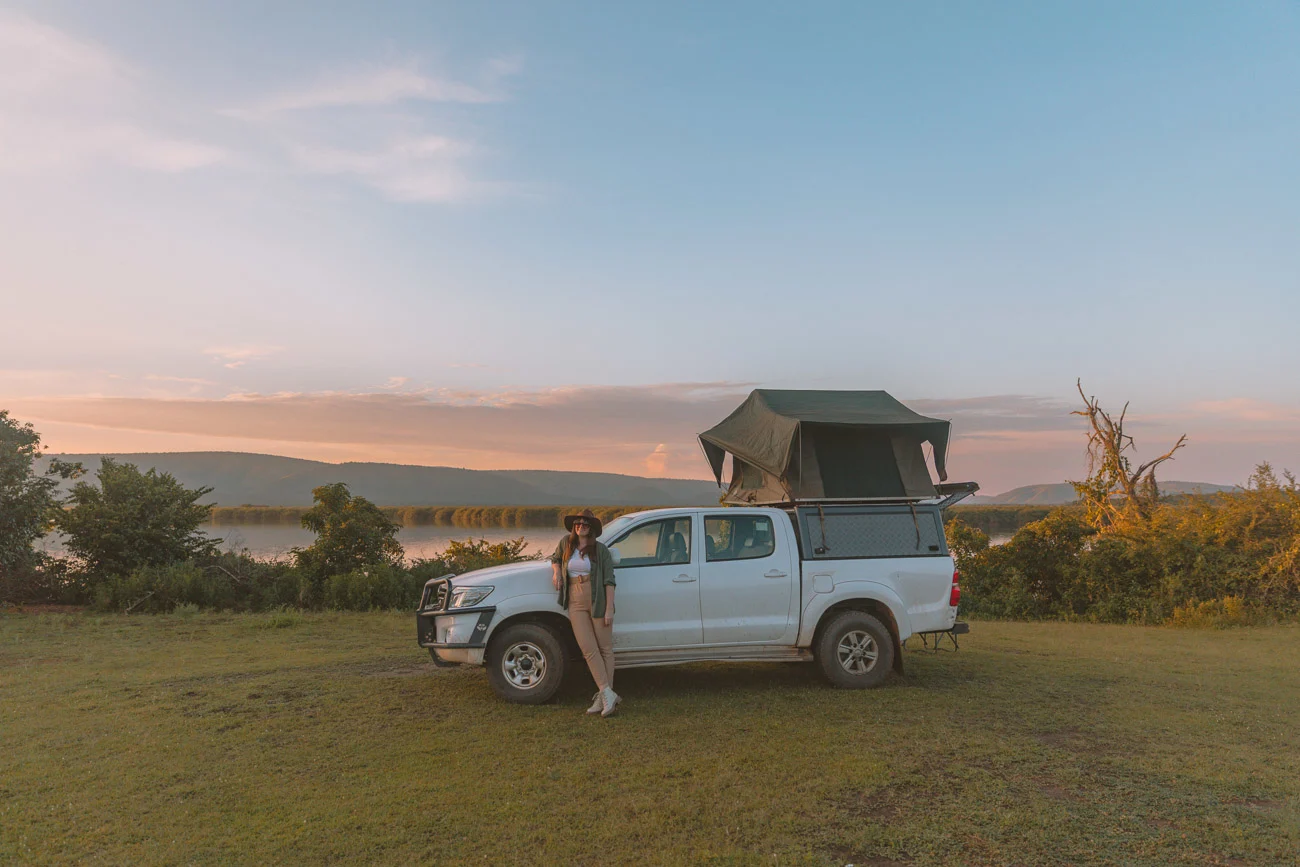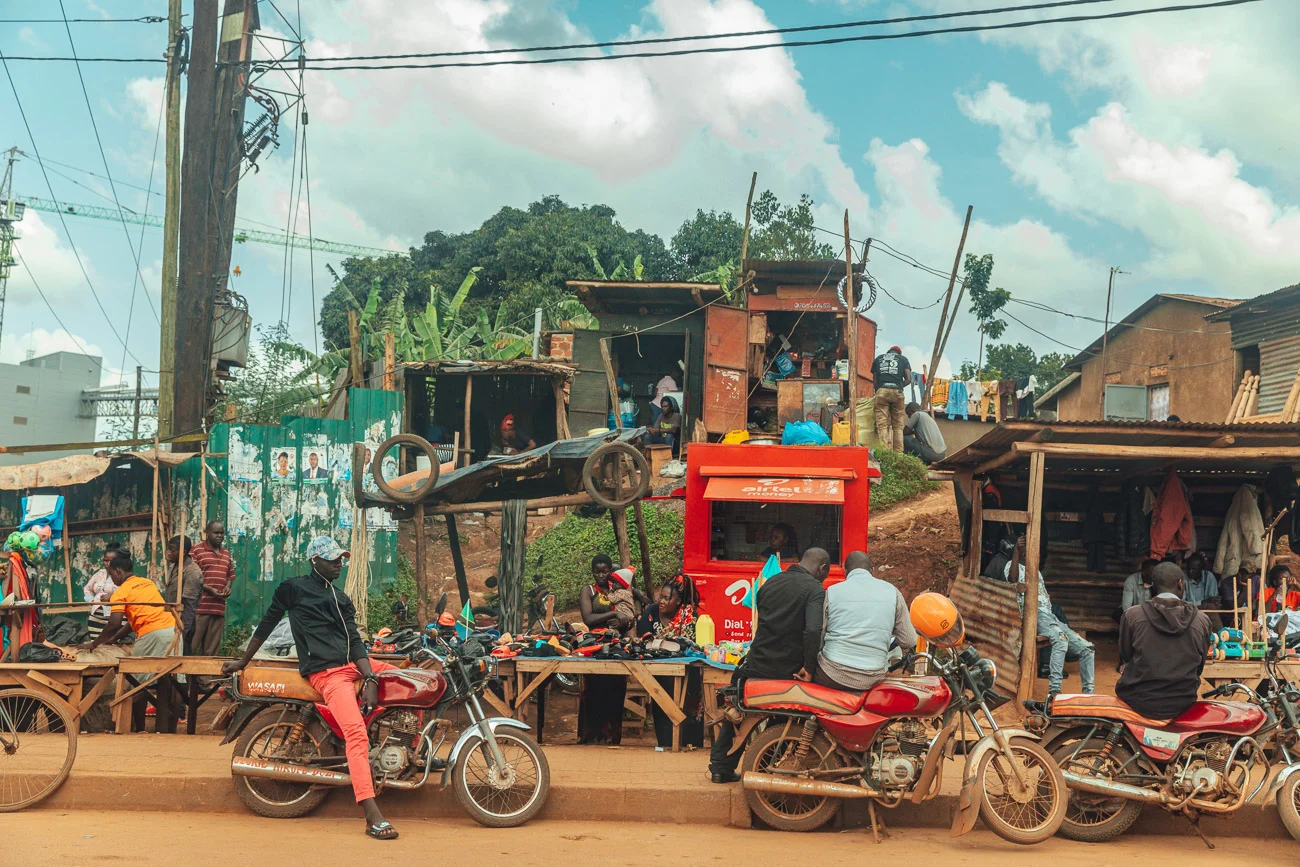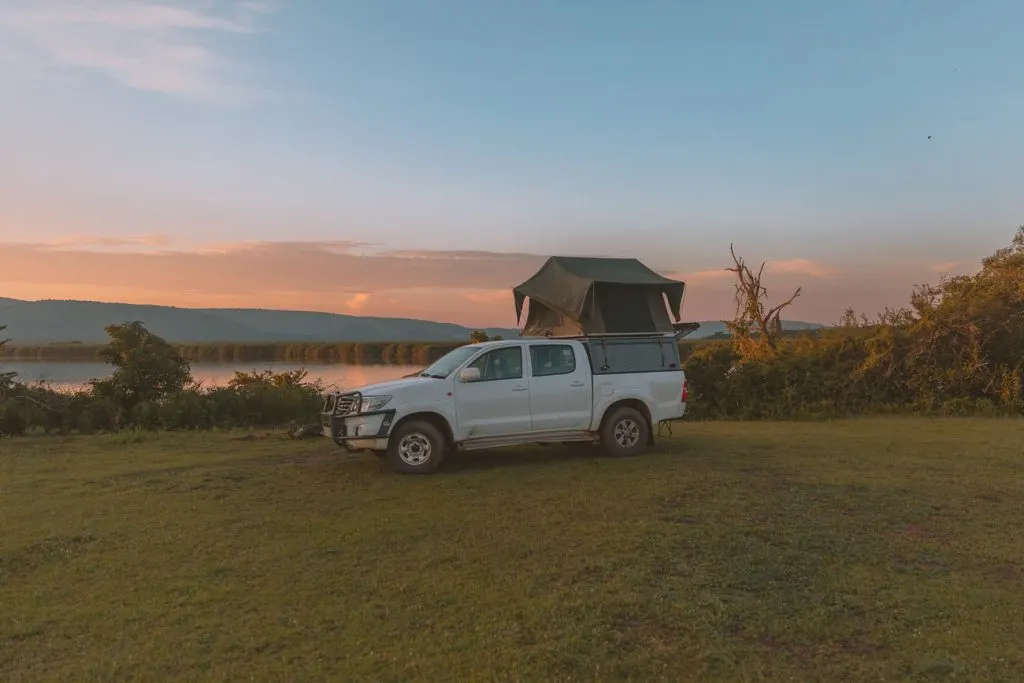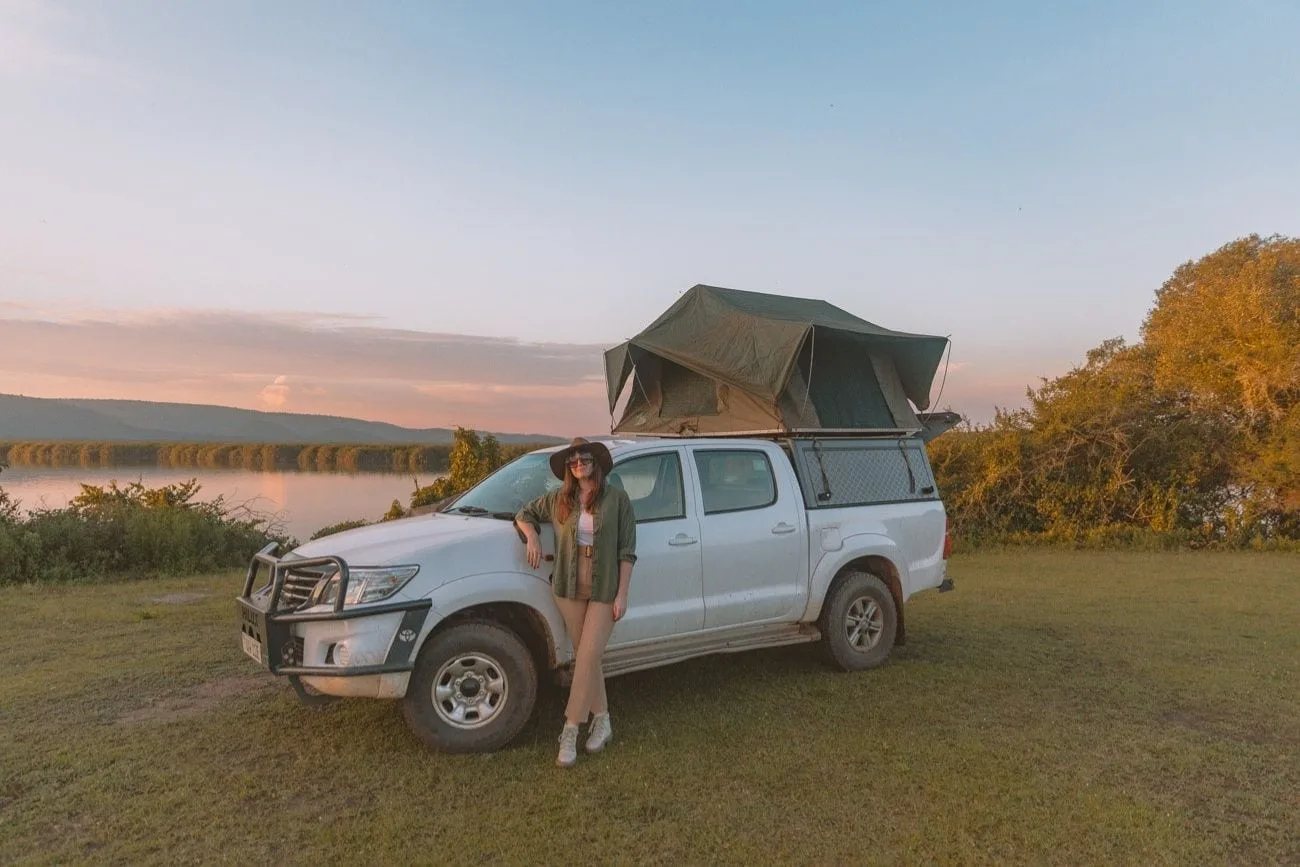Uganda is the perfect self drive destination and one of the best ways to explore the country’s many beautiful sights is by doing a roadtrip. We spent 12 days in Uganda and created the perfect 12 day Uganda itinerary with the help of Roadtrip Africa. Roadtrip Africa is a Dutch-owned company that rents vehicles in 4 African countries and they were the obvious choice for us when it came to car rental in Uganda. We opted for their Toyota Hilux, one of the newer and most comfortable options, with camping gear. In this article, you’ll find 10 reasons why you need to self drive Uganda, as well as some practical tips for when you’re on the road.
Self drive or with a driver-guide?
If you are not certain which option is good for you, then let me give you a few tips to help you decide.
Doing a self drive Uganda is perfect for those of you who want to enjoy the drive themselves, want privacy, lots of flexibility and are looking to travel around Uganda on a budget. You’ll be able to pull over anywhere, change plans as you see fit and have full control over your itinerary! With great flexibility also comes great responsibility though, so you will be the one responsible for whatever happens on the road.
Roadtrip Africa has some amazing policies for self drivers though, so even if your car breaks down, they’ll send you a new one within 10 hours anywhere in Uganda. So, make sure you go with a company that maintains and services its fleet well, and also knows how to provide backup support in case something happens. Roadtrip Uganda is the most experienced in this field and they were the first (self-drive) car rental company, catering to tourists from all over the world. I really couldn’t recommend them more!
If you decide to opt for a car with a driver-guide, which we did, these were our reasons; we love chatting to locals when traveling and since we had a tight schedule, we knew we couldn’t afford to get lost. So, we figured that to make the most of our 12 days in Uganda, we will opt for a car with a driver-guide.


Roadtrip Africa sent Godfrey to us with the car and we chatted to him about everything, and I mean, everything. Since you’ll be sitting in the car for many hours while doing a self drive Uganda, we really enjoyed being able to ask a local all the things we wondered about. We of course also enjoyed the fact that we could solely focus on taking pictures and napping, while he did all the hard work.
We saw plenty of people doing a self drive Uganda and since we would do it as well next time, here are the top 10 tips for your self drive Uganda, together with useful tips for the road trip!
1. Rent a four wheel drive
Uganda might have great asphalted main roads, but the real adventure starts when you take a turn towards the smaller roads and safaris. So, if you plan on having the same vehicle for your entire self drive Uganda experience, you must rent a 4×4.
The roads can get extremely bumpy in Uganda and you don’t want to waste time being stuck in a ditch in the middle of a national park. It will not only cost you a lot of money (they charge a hefty fee to get someone to pull you out in a national park), you’ll also be wasting a lot of time since they might need some time to get to you.

We chose to go with a Toyota Hilux Double Cab by Roadtrip Africa and didn’t get stuck anywhere for the entirety of our 12 days in Uganda. The car comfortably seats 4, but you can also be 5 people if you’re a family!
2. Opt for a car with roof tent
The best way to travel to Uganda on a budget is by renting a car with a roof tent. The tent on our car was very comfy and there are numerous campgrounds all over the country ranging from basic bush campsites inside the parks to private campgrounds operated by lodge owners, enabling you to stay at a secured site with good amenities whilst sleeping for a dime.
The opportunities for camping in Uganda are convenient year-round, thanks to its warm equatorial climate. The fancier lodges with swimming pools charge about $10 USD per person for camping on their grounds. The rate for staying at a UWA Public campsite inside a National Park is $5,50 USD per person and basic campsites outside a National Park can cost as little as $5 USD per tent. Wild camping is uncommon. If you decide to camp in a national park, there will be park staff setting up a campfire for you to prevent animals from approaching the tent or vehicle (included in the camping price).

3. Pack snacks and water
I know you’re perfectly capable of planning your meals, but we definitely weren’t! Once you stray off the main roads and into the parks, you won’t find a single shop that sells water or food. Many hours can pass in between meals if you don’t plan accordingly, so make sure you plan hearty snacks! We took cereal bars with us (2/day per person) and bought at least 3L of water in the mornings to have throughout the day. Restaurants were very hard to come by and the one place we did decide to get a ‘Rolex’ from, I got a bad stomach from. So while you definitely could be experimental with food, it might set you back a day or so if you get sick.
4. Bring good camera equipment
One of the best things about doing a self drive Uganda is the opportunity to blend in, and not be part of a bigger group of tourists, both in the cities as well as safaris. Your trip to Uganda will definitely benefit from a good zoom lens. I was a little reluctant to buy a new lens just for the sake of one trip, but I found a cheap second hand 70-300mm lens that did the job just fine. If you are traveling to Uganda to take amazing photos of animals, then I would say something up to 600mm would be your best bet – but those tend to cost a pretty penny, so also have a look if your local photo shop or website loans lenses!




Warning: Do not, and I mean it, DO NOT take selfies with African kids in barren clothes. No one needs those ‘white saviour’ vibes. Travel is all about learning and discovering – about the place you visit and yourself. So be kind and travel responsibly. Do not give candy, pens, clothes, money or anything else to the kids in Uganda, or Africa in general – this is a real problem and creates more ‘beggar children’ (a lot of East Asia already has this issue). If they get goodies from tourists, they stop going to school, their parents send them to beg and the downward spiral begins. Instead, donate money to a charity that will know better how to help or be in touch with those in charge in a community or school so they can give out your donation instead of you doing it yourself.
5. Know the road rules
Besides the information, the company you rent from will provide you with, make sure you read up on road rules before you sit in the car! The driving speed limit on the Ugandan motorways is 100 km/hour, non-urban roads 80 km/hour and on urban roads, you’ll have to maintain a speed of 50 km/hour.
Although Uganda’s asphalt roads are in good condition, you generally don’t reach more than 60km/hour, due to speed bumps. The scenery from the motorway is stunning as well, so take that into account and be ready to make a few stops along the drive.
On gravel roads, you will be driving at an average of 30km/hour. If you are trying to estimate your travel itinerary with Google Maps, increase the suggested travel time by 30%. Don’t map out your entire day route, because Google Maps will look for the shortest route and those are likely to be in a very bad state. Instead, break it up into only looking at getting from point A to point B.

I strongly recommend that you install Maps.me (free app) on your smartphone before you travel to Uganda. Download the Uganda maps and enjoy driving on GPS, offline. Almost every lodge and campsite is plotted on Maps.me, as well as on the iOverlander app.
Tip: make sure the company you rent from has comprehensive car insurance, that way there is less possibility for expensive, unexpected costs!
6. Road tripping in Uganda is safe
Since most Ugandans speak good English, they will also go out of their way to try and help you in case of an accident. Main roads outside Kampala are wide, asphalted and safe and we didn’t experience any excessive speeding or crazy behaviour.
During our 12 days in Uganda, we never felt like we needed to worry about our safety. In case you go away from the car, keep your belongings safe and covered in and not visible on the seats, especially when it comes to camera bags, wallets and phones.
7. Get ready for an ‘African massage’
I’ve mentioned how safe the main roads are above. And while main motorways are safe and comfortable to drive on, you will definitely experience something totally different once you drive off of them. Get ready to experience the ‘African ‘massage’ the moment you get off that asphalt!
We have never experienced a road as bumpy as the one going through Queen Elizabeth NP. But the experience was so much fun – we saw hippos, elephants, baboons and so many more animals by this road! This is what makes a drive through the non-asphalted roads so much better – the animals are not scared to approach them because you can’t drive fast there. And the roads and landscapes in Uganda are varied – from rainforest, mountains, lakes, savannah landscapes to cities and towns packed with motorcycles and van taxis, so you will definitely not get bored!

8. Uganda is the perfect size for a road trip
Compared to its neighbours, Kenya and Tanzania, Uganda is not that big. Meaning you can easily manage to drive from one highlight to another the next day. We had a jam-packed itinerary, but because you spend most of the time in the car, you won’t even feel exhausted. The time in the car is actually 70% of the fun and you’ll love road tripping Uganda and seeing how locals live as you pass by the small villages and towns.




9. Create your own itinerary
Planning a trip anywhere to Africa you’ll be bombarded by packaged trips. And while these could work great for those who can’t be bothered to research and have lots of money to splurge, I would say you definitely should avoid packaged tours. Whether you opt for a driver-guide or self drive Uganda, you will definitely be happy you made this choice instead of a pre-packaged tour!
With packaged tours, people often follow the same route and do the same activities many have, and many will do. It leaves no room for spontaneity and little interaction with the local community. And if you opt for a self drive Uganda then if you see you really liked one place, you’ll have the freedom to stay as long as you want to!

10. The flat tire is part of the experience
Okay, perhaps not a tip, but definitely a good thing to keep in kind! By African standards, the road conditions in Uganda are good. All the primary roads radiating out of Kampala to all four corners of the country are smooth asphalt. You can expect a lot of speed bumps and the occasional pothole. Usually, the last stretch of your daily trip requires some driving on gravel roads to get to your lodge or park entrance gate. Inside the parks, it’s off-road driving on dirt roads. The conditions of these gravel and dirt roads tend to be variable from one season to the next.
With that said, be prepared to get stuck in the mud at a certain point during your road trip after heavy rains, or even get a flat tire after driving over one too many potholes. The most difficult areas to drive are Kidepo and Bwindi. As for driving in Kampala city, the traffic jams can be absolutely horrendous, but the people still have a less aggressive way of driving than most of the bigger (especially Asian) cities I’ve traveled to.
Since the traffic moves slowly, in case of doubt who gets priority/gives way, you just seek eye contact and sort it out that way. We took an Uber car in Kampala, as well as a boda boda (motorbike taxis) and if you have a chance to rent a motorbike while in Kampala, you will definitely get around much faster with that than a car.

I hope you enjoyed these tips and reasons for a road trip and self drive Uganda! If you want to see more of what we did during our 12 days there, make sure you check out all the articles about Uganda.
Save this post for later:











